ASUS MeMO Pad HD7 Review: $149 Nexus 7.1 Successor & Our First Look at MediaTek's MT8125
by Anand Lal Shimpi on July 29, 2013 3:55 PM EST- Posted in
- Tablets
- Asus
- Mobile
- Android 4.2
- MeMO Pad
NAND, WiFi & Camera Performance
My MeMO Pad HD7 review sample included a 16GB SK Hynix eNAND eMMC 4.41 solution on-board. Internally there are two 64Gbit NAND die (2y nm class, 20 - 30nm), likely 2bpc MLC given Hynix's position on waiting for TLC until the 1y-nm node.
The eMMC is new enough to support TRIM, however the MeMO Pad HD7 ships with Android 4.2.2 which doesn't include support for fstrim. Presumably once the HD7 gets updated to Android 4.3 we'll see fstrim enabled as the hardware should support it. We really need to see better eMMC solutions focusing on improving random write performance. Even when constrained to a 100MB space the random write performance of pretty much every modern Android device is horrible at best. And what you're looking at here is best case performance. Fill the eMMC and you'll see significantly worse performance over time. The only recommendation I can offer is to keep at least 25% of your internal storage free. I haven't done much digging to see how these bargain basement eMMC solutions behave over time when given tons of spare area, so it's possible that the 25% recommendation may not be enough. I've started some experimentation with the Nexus 7 and I hope to have something to report in the not too distant future.
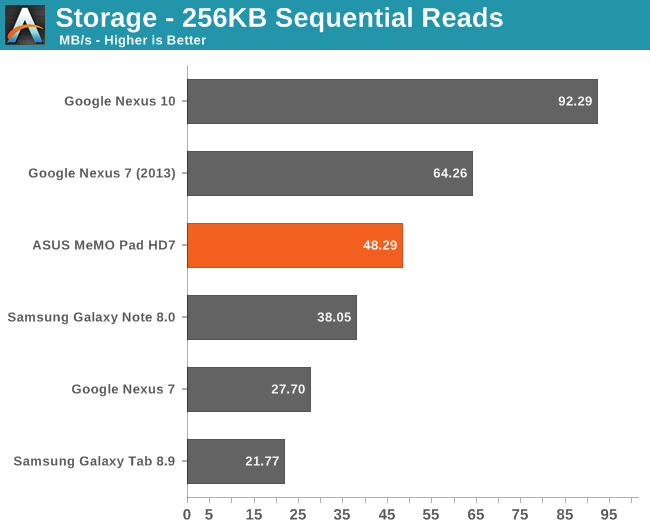
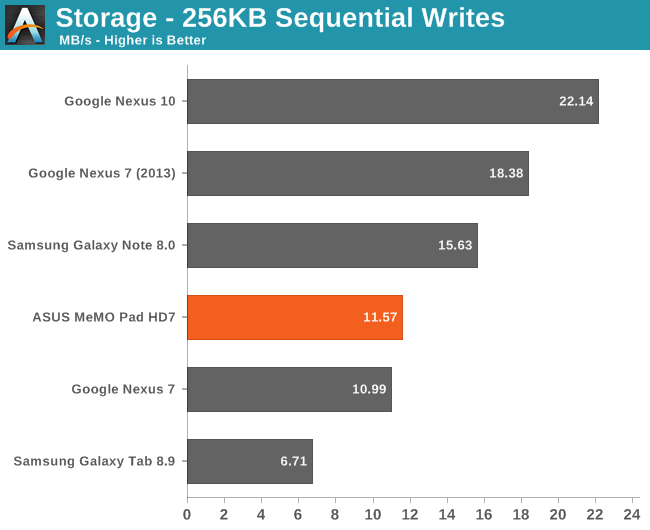
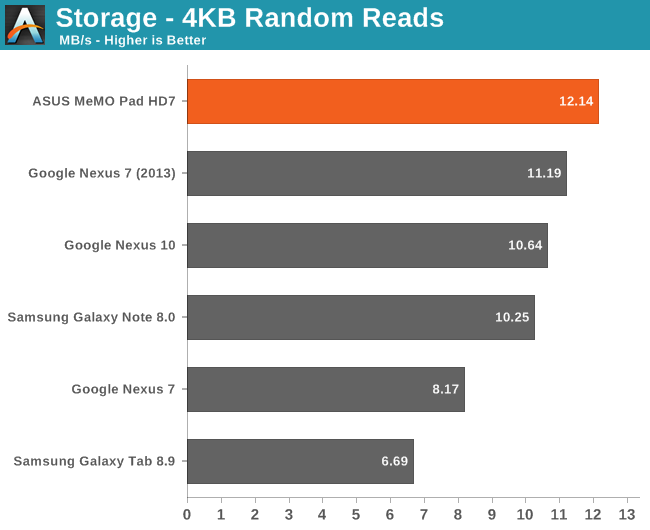
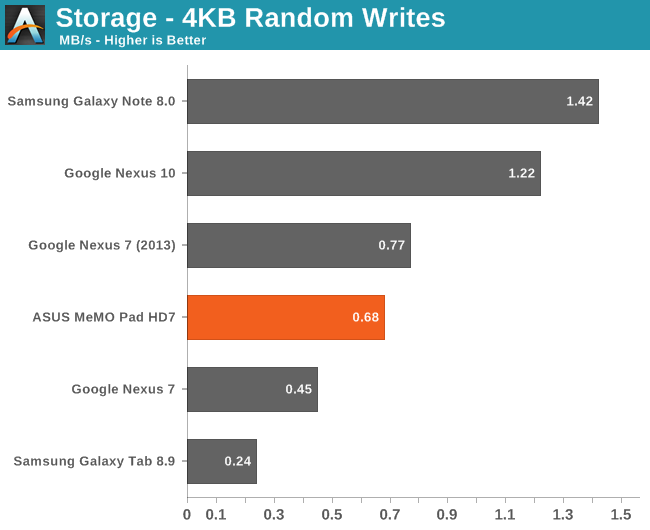
Quite possibly the biggest tradeoff/drawback, the MeMO Pad HD7 only features a single antenna 2.4GHz 802.11n WiFi solution. WiFi is provided courtesy of MediaTek's own MT6628 WiFi/BT/GPS/FM combo chip.
Its peak performance is actually really good though:
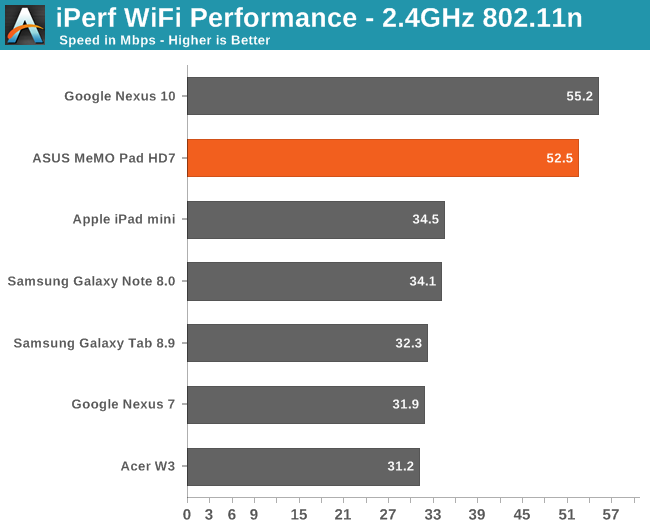
Although GPS is supported by the MT6628, GPS isn't enabled on the HD7. Update: I was very wrong here. GPS is supported and enabled on the MeMO Pad HD7. Sorry!
The 5MP rear facing camera is a nice addition over the original Nexus 7. Image quality is reasonable in a pinch. ASUS' camera UI is nice and quick, with a high framerate downsampled preview. As always, toss enough light on the subject and the results can be pretty decent:
I threw some sample images in the gallery below. Video is encoded at 17Mbps H.264 main profile.


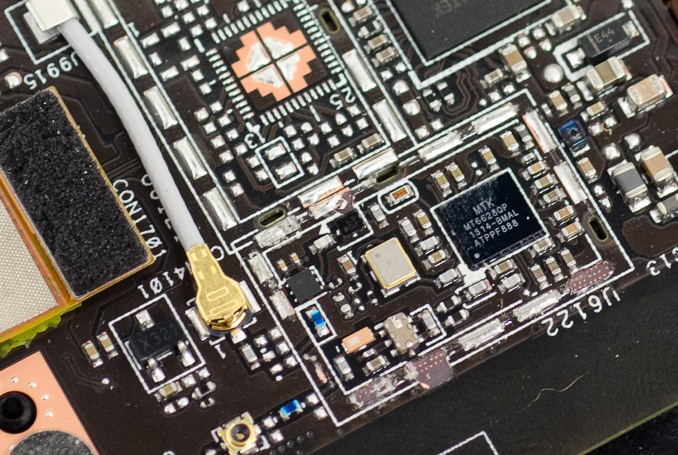















75 Comments
View All Comments
Qwertilot - Tuesday, July 30, 2013 - link
A bit scary really this. Judged objectively, this thing is a big percentage - 80? - per cent of an ideal small tablet and the new Nexus 7 is a bigger one. Huge improvements would need battery breakthroughs. Yet they're both down at very low prices.Budget PCs really do seem to have an awful lot further to come.
HighTech4US - Tuesday, July 30, 2013 - link
Anand why on the "ASUS 7-inch Tablet Specification Comparison" chart (or anywhere in the review) are the different sensors each tablet has (or doesn't have) not mentioned?Because of the lack of complete specifications I have to dig deeper on other sites to get a complete picture of what each Tablet offers. That really shouldn't happen.
-----
Again a lack of sensors, especially GPS really make these lower cost tablets not very useful.
No GPS means NO Google Maps.
Arbie - Tuesday, July 30, 2013 - link
It's great that this Asus tablet has micro-SD. I won't even consider a tablet that doesn't. It is hugely quicker to swap media sets in and out using SD than any other way. For my uses, the size of internal memory is much less important.Regarding SD formatting, here's a utility that let me put a 64GB card in an circa 2009 media player. Get it at: http://www.ridgecrop.demon.co.uk/index.htm?fat32fo...
Arbie - Tuesday, July 30, 2013 - link
Also, Anand, the presence or lack of micro-SD should appear in the "Basic Tablet Specification Comparison" table. This is really important to people, even if Google and Amazon downplay it for their own marketing reasons. Just look at the number of comments on this topic.Wwhat - Tuesday, July 30, 2013 - link
I don't think the absence of SD-card slots on google's devices has anything to do with cost whatsoever, SD-card slots are easy and cheap and available on the lowest of budget devices,It's more an attempt to force people to do everything through (google-)cloud storage I think, as the article states
And yes it's stupid and I'd even say nasty since it would cost them next to nothing to add it.
'don't be evil'? I think there is a reason they abandoned that mantra.
The question now is: What can we the consumers do about it? Are there attachment you can connect to the nexus to add a SD slot without the thing getting too ridiculously messy? Anybody know?
user777 - Thursday, August 1, 2013 - link
I have Nexus 7 2012 and there is no problem to use USB OTG cable + USB stick (or Transcend USB stick with microSD+SD card slot). I use Total Commander+USB Stick plugin (free). It is possible to open any doc/pdf/jpeg/avi/mp4 file.It is possible to share any folder or external HDD at your laptop and to use like WiFi Network LAN storage using ES File Explorer. It is possible to play any movie using streaming (without downloading) from the Network LAN storage (MX Player or BS Player). It is even possible playing movie from WiFi FTP server.
n13L5 - Wednesday, July 31, 2013 - link
Quoting the Article: "Google was pretty adamant against including a microSD slot in the original Nexus 7 (preferring a combination of internal and cloud storage), but ASUS put one back in the design of the MeMO Pad HD7."Good Asus, bad Google, stop being evil, k? Stupid cloud not always accessible.
evolucion8 - Wednesday, July 31, 2013 - link
Hi, I have a question, which CPU monitoring software did you use to monitor the CPU usage during videoplayback? Looks sleek and lean!user777 - Wednesday, July 31, 2013 - link
Smal mistake at the ASUS 7-inch Tablet Specification Comparison:ASUS Nexus 7 (2012) has 1.2MP front-facing camera
user777 - Wednesday, July 31, 2013 - link
Just got the official Android 4.3 upgrade on my Nexus 7 2012.Would be glad to see the performance of the new Android version 4.3 at the storage random write tests for the old Nexus 7 and new Memo Pad HD 7.